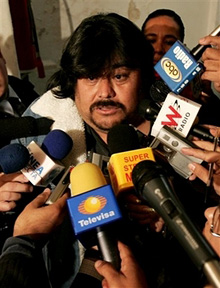 |
 |
 |
 News Around the Republic of Mexico | December 2006 News Around the Republic of Mexico | December 2006  
Leader of Oaxaca Protests Arrested
 Mark Stevenson - Associated Press Mark Stevenson - Associated Press


| | Flavio Sosa one of the founders of the Oaxaca People's Assembly, APPO, arrives at news conference in Mexico City, Mexico, Monday, Dec. 4, 2006. Police arrested Flavio Sosa, the emblematic leader of a six-month-long leftist protest movement that took over the southern city of Oaxaca and battled authorities, authorities reported on Monday. Sosa, whose heavyset, bearded presence become almost a symbol of the leftist People's Assembly of Oaxaca, was detained late Monday in Mexico City, federal police said, though they gave no immediate information on the circumstances of the arrest. (AP/Eduardo Verdugo) |
Mexican police arrested the symbolic leader of a six-month-long protest movement that took over southern Oaxaca city, hours after he gave a news conference saying he had come to the capital to start talks with the government.

Flavio Sosa, whose heavyset, bearded presence became an emblem of the leftist People's Assembly of Oaxaca, was arrested late Monday in Mexico City on charges of kidnapping, robbery, and causing damages and injuries, federal prosecutors said in a press statement. The allegations were apparently related to the barricades, vandalism and irregular detentions carried out by some protesters.

"Sosa ... is known for his use of violence, damaging private property and public byways, and also burning vehicles and buildings in Oaxaca City," prosecutors said.

Sosa was taken to a maximum security prison just west of Mexico City for arraignment. The facility that holds some of the nation's most dangerous prisoners.

While Sosa is a member of a larger leadership council, he appeared to be largely in control of the protest movement, and police called him "the main leader."

Sosa has downplayed his role, saying last month, "We are all equal. But my big beard and big stomach have made me become the favorite leader of the press and the police."

On Monday before his arrest, Sosa told reporters he had come to Mexico City in an attempt to re-establish negotiations with the government and escape what he described as persecution in Oaxaca. A spokesman for the people's assembly, Florentino Lopez, told the government news agency Notimex that talks would continue with the government despite Sosa's arrest, but it was unclear who would represent the protesters.

Just a few hours before he was detained, Sosa held a news conference in which he said he left Oaxaca to avoid the "fierce persecution of the police and Ulises Ruiz' hit men," referring to Oaxaca Gov. Ulises Ruiz, whose resignation the protesters had demanded.

Local media reported that two other leaders of the movement, known as APPO, had also been arrested, but there was no immediate confirmation of that.

Leaders who accompanied Sosa at the news conference said that a total of 220 protesters have been detained during the conflict in Oaxaca, though police cite a figure of around 170. Protesters also claimed some of those detained had been beaten, and that another 70 supporters of the movement are missing.

Sosa's brother, Horacio, was with him and was arrested at the same time in Mexico City, on unspecified charges.

While Oaxaca City — once a magnet for tourists — is slowly regaining some semblance of normality after burned-out vehicles and improvised barricades were removed from the streets, anger continues to smolder there.

Sosa said on Monday that the situation in Oaxaca could evolve into an armed conflict, something he said he hoped can be avoided. "They (authorities) could leave the people with no options. Since they are spreading hate, this could unleash itself at any moment."

The protesters, ousted from the city's center by a police raid in late October, have vowed to keep pressing their demand for Ruiz's resignation and are calling for a "mega-march" on Saturday.

The conflict began in late May as a strike by teachers seeking higher pay, but quickly exploded into a broader movement including Indian groups, students, farmers and myriad left-leaning activists, all organized under APPO.

The conflict kept residents away from the city's historic center and forced nearly all the shops and restaurants to close their doors.

Located about 520 kilometers (325 miles) southeast of Mexico City, Oaxaca is one of the country's premier tourist destinations with its colonial architecture and Indian crafts. But tourism plummeted amid the violence, which prompted the U.S. and several other foreign governments to warn their citizens against traveling to the city.

Among those killed in the protests was freelance video journalist Bradley Roland Will, 36, of New York, who was filming a clash between protesters and a group of armed men.

The violence seemed to come to a head last week when protesters set colonial-era buildings on fire, prompting police to begin arresting demonstrators. Many detainees have been transferred to a federal prison hundreds of miles (kilometers) away in Nayarit state, and many APPO leaders went into hiding after authorities issued warrants for their arrest. | 
 | |
 |



